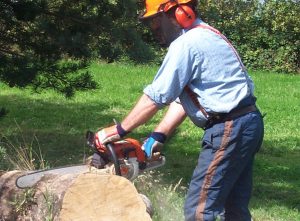You don’t need special training or certification if you’re using a chainsaw on your own land but you do if you’re using it anywhere else.
It’s constantly changing, but at the time of writing, in the UK, there are two main recognised governing bodies: the National Proficiency Tests Committee (NPTC) and Lantra. They can both provide either integrated training and assessment or independent assessment after training elsewhere. You can find locally-registered training providers through their websites. The training provider will put together a package based on your needs. After training and successful assessment, you will receive a certificate and a card.Integrated training and assessment (ITA) is where the trainer also provides assessment as part of the training package. ITA certification is valid for 3-5 years, after which it has to be repeated. Training followed by independent assessment via Lantra or NPTC (non-ITA) provides you with certification for life.There are different levels of training. The basic cross-cutting and maintenance course is a pre-requisite for all other courses, including felling trees of up to 200mm (8″) diameter and felling trees of up to 380mm (15″). There are courses for felling bigger trees, for which the 380mm course is a pre-requisite. There are lots of other more specialist courses too – for example the ‘climbing’ courses for tree surgeons, where chainsaws are hauled up into the tree. All these courses require the cross-cutting and maintenance and 380mm felling courses as prerequisites.The very least you need, even for basic chainsawing on your own land, is proof that you’ve done a basic (unassessed) cross-cutting & maintenance course. You can ask for some sort of certification from the training provider. If you have an accident on your own land and hurt yourself, the hospital will be obliged to report the incident to the Health & Safety Executive, who, in a worst-case scenario, could take you to court for injuring yourself.However, we’d recommend good quality training and assessment, which will save you money in the long run (you’ll sharpen and maintain the saw better, which will prolong its life and use less fuel), and more importantly, be safer.Whatever training you undertake, if you’re an occasional user, you need a refresher course every three years, otherwise you could invalidate your insurance and upset the HSE. For professionals, it’s every five years.

See here (under ‘Forestry and Arboriculture) for lists of factsheets, work sheets and qualifications guidance for a range of techniques involving chainsaws. This will explain what level of competence you need to achieve to get these qualifications.

